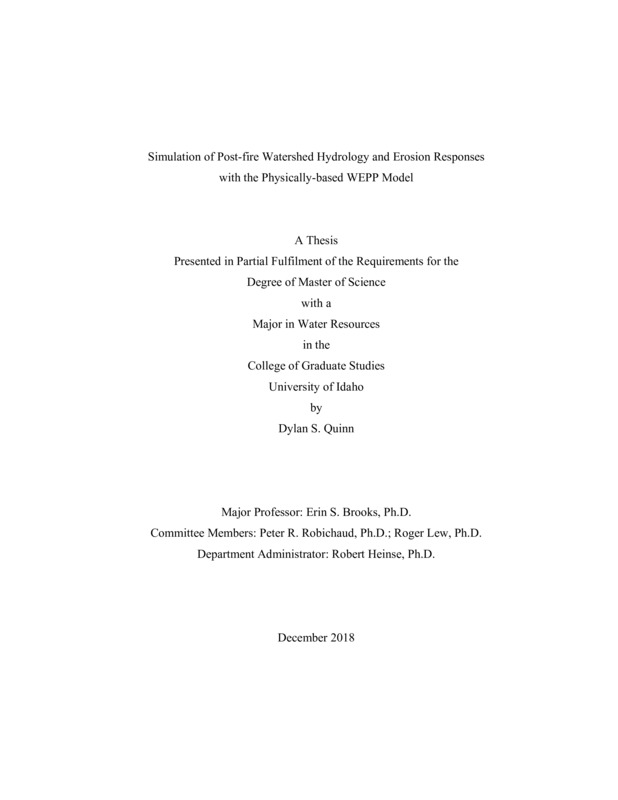Simulation of Post-fire Watershed Hydrology and Erosion Responses with the Physically-based WEPP Model
Quinn, Dylan S. (2018-12). Simulation of Post-fire Watershed Hydrology and Erosion Responses with the Physically-based WEPP Model. Theses and Dissertations Collection, University of Idaho Library Digital Collections. https://www.lib.uidaho.edu/digital/etd/items/quinn_idaho_0089n_11453.html
- Title:
- Simulation of Post-fire Watershed Hydrology and Erosion Responses with the Physically-based WEPP Model
- Author:
- Quinn, Dylan S
- Date:
- 2018-12
- Keywords:
- Erosion Fire Hydrology Modeling
- Program:
- Water Resources
- Subject Category:
- Water resources management; Environmental science
- Abstract:
-
The cascading consequences of fire-induced ecological changes have profound impacts on both natural and managed forest ecosystems. In many areas, natural and human-caused wildland fire are becoming more prevalent due to historical management practices exacerbated by climate change . The susceptibility of landscapes to post-fire soil erosion and runoff have been closely linked with the severity of the wildfire, and forest managers tasked with implementing mitigation strategies need robust tools to evaluate the effectiveness of their decisions, particularly those affecting hydrological recovery. Various hillslope-scale interfaces of the physically-based Water Erosion Prediction Project (WEPP) model have been successfully validated for this purpose using fire-effected plot experiments, however these interfaces are explicitly designed to simulate single hillslopes. Spatially-distributed, catchment-scale WEPP interfaces have been developed over the past decade, however none have been validated for post-fire conditions, posing a barrier to adoption for forest managers. The work proposed here will address concerns of model validity by developing new processing frameworks which enhance the ability of the spatial WEPP model to capture hillslope-scale patterns in burn severity. These methods will be applied to compare simulations results with five years of post-fire runoff and erosion observations for a 117 ha forested watershed after the 2011 Wallow Fire in Eastern Arizona. Further, visualization strategies will be developed and implemented into current online spatial WEPP interfaces which facilitate usability and adoption of such models .
- Description:
- masters, M.S., Water Resources -- University of Idaho - College of Graduate Studies, 2018-12
- Major Professor:
- Brooks, Erin S.
- Committee:
- Robichaud, Peter R.; Lew, Roger
- Defense Date:
- 2018-12
- Identifier:
- Quinn_idaho_0089N_11453
- Type:
- Text
- Format Original:
- Format:
- application/pdf
- Rights:
- In Copyright - Educational Use Permitted. For more information, please contact University of Idaho Library Special Collections and Archives Department at libspec@uidaho.edu.
- Standardized Rights:
- http://rightsstatements.org/vocab/InC-EDU/1.0/

